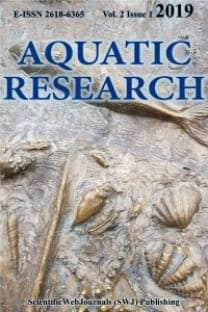PROCESSING OCEANOGRAPHIC DATA BY PYTHON LIBRARIES NUMPY, SCIPY AND PANDAS
___
Beazley, D.M. (2009). Python essential reference. AddisonWesley Professional. Available at www.python.org (accessed 18.03.2019)Bogdanov, I., Huaman, D., Thovert, J.-F, Pierre, G., Adler, P.M. (2011). Tectonic stresses seaward of an aseismic ridge Trench collision zone. A remote sensing approach on the Loyalty Islands, SW Pacific. Tectonophysics, 499, 77-91.
Hunter, J.D. (2007). Matplotlib: A 2D graphics environment. Computing in Science & Engineering, 9(3), 90-95.
Bogolepov, K. V., Chikov, B. M. Geologiya dna okeanov (Geology of the ocean floor). Russian. Ed. by Saks, V. N., Fotiadi, E. E. Moscow: Nauka, 1976, 246.
Brune, S. (2016). Plate Boundaries and Natural Hazards. AGU Geophysical Monograph 219. ed. by Duarte, J. C. & Schellart, W. P. Sydney, Australia: AGU. Chap. Rifts and rifted margins: A review of geodynamic processes and natural hazards, 1-21.
Jones, E., Oliphant, T., Peterson, P. (2014). SciPy: open source scientific tools for Python. Available at www.scipy.org (accessed 23.03.2019)
NumPy community (2019). NumPy Reference. Release 1.16.1. 1372 p.
Contreras-Reyes, E., Carrizo, D. (2011). Control of high oceanic features and subduction channel on earthquake ruptures along the Chile-Peru subduction zone. Physics of the Earth and Planetary Interiors 186, 49-58.
Crameri, F. (2018). Geodynamic diagnostics, scientific visualisation and StagLab 3.0. Geoscientific Model Development, 11, 2541-2562.
Cui, W., Hu, Y., Guo, W., Pan, B., Wang, F. Reprint of a preliminary design of a movable laboratory for hadal trenches. Methods in Oceanography, 10(2014), 178- 193.
Cui, W., X., Wu (2018). A Chinese strategy to construct a comprehensive investigation system for hadal trenches. Deep-Sea Research Part II 155, 27–33.
Dierssen, H.M., Theberge, A.E.J. (2014). Encyclopedia of Natural Resources. Taylor & Francis. Chap. Bathymetry: Features and Hypsography, 1–7. https://doi.org/10.1081/E-ENRW-120048589
Doglioni, C. (2009). Comment on ’The potential influence of subduction zone polarity on overriding plate deformation, trench migration and slab dip angle’ by W.P. Schellart. Tectonophysics, 463, 208-213.
Dokht, R.M.H., Gu, Y.J., Sacchi, M.D. (2016). Waveform inversion of SS precursors: An investigation of the northwestern Pacific subduction zones and intraplate volcanoes in China. Gondwana Research, 40, 77-90.
Fernandez, M.O., Marques, A.C. (2018). Combining bathymetry, latitude, and phylogeny to understand the distribution of deep Atlantic hydroids (Cnidaria). DeepSea Research Part I, 133, 39-48.
Gorbatov, A., Fukao, Y., Widiyantoro, S., Gordeev, E. (2001). Seismic evidence for a mantle plume oceanwards of the Kamchatka Aleutian trench junction. Geophysical Journal International, 146, 282-288.
Hubble, T., Webster, J., Yu, P., Fletcher, M., Airey, D., Clarke, S., Mitchell, D., Voelker, D., Puga-Bernabeu, A., Howard, F., Gallagher, S., Martin, T. (2016). Submarine Mass Movements and their Consequences. Advances in Natural and Technological Hazards Research. ed. by G. Lamarche. Switzerland: Springer International Publishing. Chap. Chapter 12. Submarine Landslides and Incised Canyons of the Southeast Queensland Continental Margin, 125-134. https://doi.org/10. 1007/978- 3-319-20979-1_12
Ikari, M.J., Kameda, J., Saffer, D.M., Kopf, A.J. (2015). Strength characteristics of Japan Trench borehole samples in the high-slip region of the 2011 Tohoku-Oki earthquake. Earth and Planetary Science Letters, 412, 35-41.
Jamieson, A.J. (2018). A contemporary perspective on hadal science. Deep-Sea Research Part II, 155, 4-10.
Kong, X., Li, S., Wang, Y., Suo, Y., Dai, L., Géli, L., Zhang, Y., Guo, L., Wang, P. (2017). Causes of earthquake spatial distribution beneath the Izu-Bonin-Mariana Arc. Journal of Asian Earth Sciences, 151, 90-100.
Lemoine, A., Madariaga, R., Campos, J. (2002). Slab-pull and slab-push earthquakes in the Mexican, Chilean and Peruvian subduction zones. Physics of the Earth and Planetary Interiors, 132, 157-175.
Litvin, V.M. (1987). Morfostruktura dna okeanov (Morphostructure of the ocean floor). In Russian. Ed. by A. N. Lastochkin. Leningrad: Nedra. 275.
Loher, M., Marcon, Y., Pape, T., Römer, M., Wintersteller, P., Santos Ferreira, C. dos, Praeg, D., Torres, M., Sahling, H., Bohrmann, G. (2018). Seafloor sealing, doming, and collapse associated with gas seeps and authigenic carbonate structures at Venere mud volcano, Central Mediterranean. Deep-Sea Research Part I, 137, 76-96.
Luo, M., Algeo, T.J., Tong, H., Gieskes, J., Chen, L., Shi, X., Chen, D. (2018). More reducing bottom-water redox conditions during the Last Glacial Maximum in the southern Challenger Deep (Mariana Trench, western Pacific) driven by enhanced productivity. DeepSea Research Part II, 155, 70-82.
Mao, X., Zhang, B., Deng, H., Zou, Y., Chen, J. (2016). Three-dimensional morphological analysis method for geologic bodies and its parallel implementation. Computers & Geosciences, 96, 11-22.
Masson, D.G. (1991). Fault Patterns at Outer Trench Walls. Marine Geophysical Researches, 13, 209-225.
Oliphant, T.E. (2007). Python for scientific computing. Computing in Science & Engineering 9(3), 10-20.
Pedregosa, F., Varoquaux, G., Gramfort, A., Michel, V., Thirion, B., Grisel, O., Blondel, M., Prettenhofer, P., Weiss, R., Dubourg, V., Vanderplas, J., Passos, A., Cournapeau, D., Brucher, M., Perrot, M., Duchesnay, E. (2011). Scikit-Learn: machine learning in Python. The Journal of Machine Learning Research, 12, 2825-2830.
Perez, F., Granger, B.E. (2007). IPython: a system for interactive scientific computing. Computing in Science & Engineering 9(3), 21-29.
R Core Team. (2014). R: a language and environment for statistical computing. Vienna. Available at http://www.R-project.org (accessed 14.12.2018)
- ISSN: 2618-6365
- Yayın Aralığı: 4
- Başlangıç: 2018
- Yayıncı: Nuray ERKAN ÖZDEN
PROCESSING OCEANOGRAPHIC DATA BY PYTHON LIBRARIES NUMPY, SCIPY AND PANDAS
PRESENT STATUS OF STURGEON IN THE LOWER SAKARYA RIVER IN TURKEY
Devrim MEMİŞ, Deniz Devrim TOSUN, Güneş YAMANER, Gökhan TUNÇELLİ, Jörn GESSNER
Gürkan DİKEN, Orhan DEMİR, Mehmet NAZ
POTENTIAL ENVIRONMENTAL IMPACTS OF TUNA CAGE FARMING IN THE AEGEAN SEA
Rıdvan Kaan GÜRSES, Yeşim BÜYÜKATEŞ, Murat YİĞİT, Sebahattin ERGÜN, H. Göksel ÖZDİLEK
MODELLING THE PROGRESS AND EFFECTS OF EUTROPHICATION IN INLAND AND COASTAL WATERS
